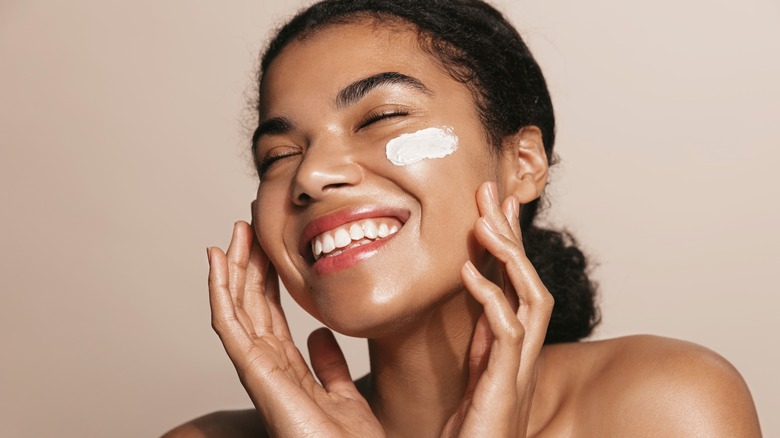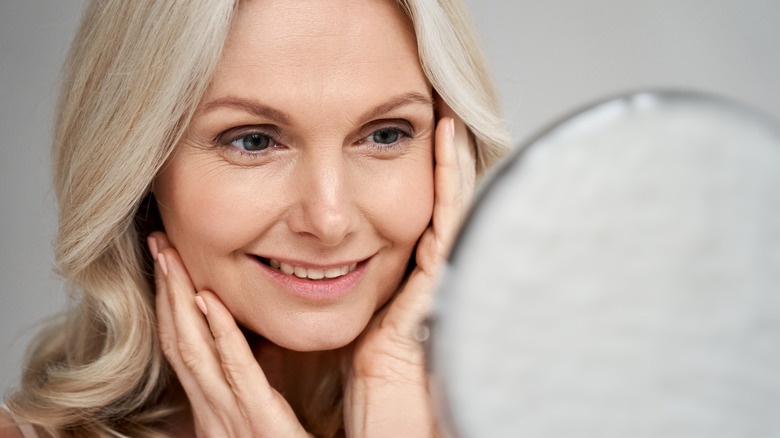Malic Acid Is The Perfect Alternative To Retinol For Sensitive Skin
There's no magic wand to wave to get perfectly clear, smooth, radiant skin, but there is a plethora of beauty products that can help. One seemingly magical ingredient is retinol. Derived from vitamin A, it can be used to treat a number of skin conditions for seemingly every skin type. Retinol can do a lot of things for your face. It can help with clogged pores, acne, age spots, wrinkles, and just overall general skin dullness.
But no product is perfect. Retinol can be pretty strong and leave you with red, irritated, and stinging skin — kind of the opposite of how you want your skin to look and feel. For those with already sensitive skin, even a low dose of retinol may cause irritation. Retinol is also not recommended if you're pregnant or breastfeeding, according to research published in the Canadian Family Physician.
Clearly, retinol isn't for everyone, so If you're looking for some of the same benefits of retinol but without the same potential side effects, you should check out malic acid.
Malic acid is a gentle exfoliator thanks to its chemical structure
So what is malic acid? It's an alpha hydroxy acid (AHA) that can be found in fruits like apple, plums, cranberries, and grapes; its presence in grapes makes it a big deal for wine makers. As for its use in skincare products, as an alpha hydroxy acid, it works as an exfoliator to brighten skin and unclog pores, notes Well + Good. It can also reduce fine lines, wrinkles, and hyperpigmentation, aka age spots. Plus, it's a humectant, so it helps keep skin hydrated and healthy.
The reason that malic acid is particularly good for sensitive skin is because of its chemical structure; its molecules are larger than other acids, like glycolic acid, according to Byrdie. Larger molecules equal less skin penetration, which means less chance of irritation. Though there is a flip side to that size issue. Malic acid may do a lot of the same things that a retinol-based product can do, but it just isn't as effective because of the reduced skin penetration. That's true as well when it's compared to other alpha hydroxy acids.
Malic acid is most effective paired with other alpha hydroxy acids
The gentleness of malic acid makes it a good fit for combining with other alpha hydroxy acids. Scientific research has shown that malic acid can be more effective when paired with lactic acid or glycolic acid. If you do want to combine and layer your AHA-based products, it's probably best to leave the acid layering to professionals, since you don't want to end up with irritated skin with a mismatch of active ingredients.
If you want to find out about the benefits of malic acid first hand, there are some good options. Malic acid from apple juice is one of the active ingredients in Juice Beauty's Green Apple Collection, which includes masks, serums, and daily moisturizers. Founder Karen Behnke explained to The List that the products are good for anti-aging since the malic acid in them "can help even skin tone and texture and even [minimize] the appearance of sun damage."
Beauty Counter's Reflect Effect Overnight Resurfacing Peel pairs malic acid with other alpha hydroxy acids as well as beta hydroxy acids to help you start the day with bright, smooth skin. The Clarifying Mask by Tata Harper, which can also be used as an exfoliating scrub, gets its malic acid from sugar maple.


